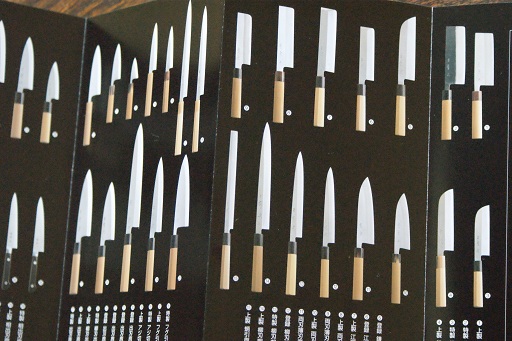.jpg)
Buying a knife in Kyoto:
Knives in Japan:
Japanese knives are becoming famous and popular.
I mentioned it on the "store page(in the column to the right)"
two of the best knife stores in Kyoto.
-Shigeharu, the oldest knife store in Kyoto. Actually, Shigeharu is one
of the oldest stores(of all categories) in Kyoto.
-Aritsugu, one of the most famous and trusted brands of knives all acroos
Japan. Aritsugu of Kyoto, all cooks in Japan knows.
Now, maybe you are interested in buying one.
How much are the knives? Are they very expensive? What are different types
of Japanese knives?
For regular home cooking, there are 4 types of knives you want to search
from.
Professional, but also for home cooking:
1. DEBA - Thick and heavy for cutting meat. They are thick so you can cut
through bones.
2. USUBA - Thinner, lighter, vegetable knife for easier fast stroke cutting.
*There is also very similar NAKIRI. In general, USUBA is single edged and
NAKIRI is double edged.
3. YANAGIBA - Sashimi knife. Long knife to cut soft raw fish in one stroke
without damaging it.
Home cooking, but also for professionals:
4. SANTOKU - All purpose kitchen knife. If you are buying just one, this
is recommended.
This is the knife catalog by Aritsugu:

TOP LINE:
On the top right corner, there are two NAKIRI knives.
To the left of NAKIRI, there are five USUBA knives.
*East Japan type is square and West Japan type is more round at the tip.
BOTTOM LINE:
From the right, two more USUBA.
Then, two SANTOKU to the left.
Then, the four skinnier and longer knives are YANAGIBA.
Bottom left area(with wooden handles) are series of DEBA knives.
*You see one long skinny DEBA in the middle and you might be confused.
This particular one is mixture of DEBA and YANAGIBA.
Price:
For all types of knives that I mentioned above, 12,000yen to 15,000yen
is the standard price for a regular class & medium size knife.
For each type of knife, there are different classes(generally, three classes. 1.regular 2.high 3.very high). This means, better quality of the steel and/or more skilled skilled making
of the steel for the higher class.
This is why, some of the higher quality and skilled knives are hundreds
of thousand yen(thousnads of US dollars).
For each type of knife, there are different sizes. In genearl, bigger knives are used for cutting bigger things(big fish,
big vegetables) and smaller ones for smaller things(small fish, vegetable
peeling). I recommedn medium size for home cooks, because larger ones are
too big for regular size cutting boards anyway. Also, medium size can somehow
manage peeling, etc. Also, most houses would have a peeler or petit knife.
All in all, I recommend, regular class and medium size.
Medius size is already a life time quality for most of the home cooks.
Unlike stainless steel knifes, these tough knives need to be sharpend only
once a month or so.
Taking care of the knife:
Some people ask me, "do I need to oil the knife so it will not rust?"
Almost none of us do that in Japan.
Maybe, if you know that you won't use the knife for the next 3 months,
it is a good idea.
Tips to use the knives wisely.
When using a knife, try to keep it as dry as possible. Prepare a cloth
next to the cutting board.
After washing, get it completely dry using a cloth. COMPLETELY DRY. The
handle, too.
Then, put it back.
Sharpening a Japanese knife requires a good sharpener(a sharpening stone).
Most Japanese knives have a single edged blade. Therefor, many of the kitchen
knife sharpeners you see overseas, that you put the blade in and give it
a few strokes back and forth, do not work.
Standatd sharpening stones, you can buy them for around 4,000yen.
Buying it together with the knife is a good idea.
|
.jpg)